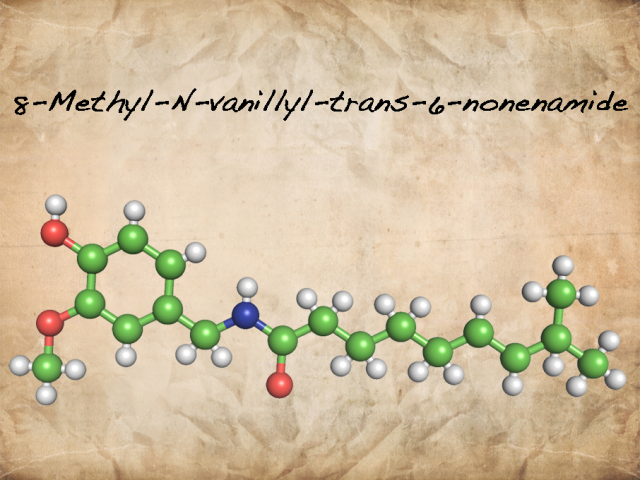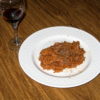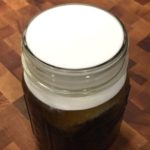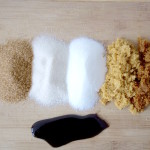
Most likely if you see 8-Methyl-N-vanillyl-trans-6-nonenamide written on a product you will assume it is not good for you… Oh chemicals… not good. Well no this is one of the substances that give to the chili peppers the heat. It is a molecule that is very closely related to the molecule of vanillin. It is an amide (the blue atom shown in the structure is nitrogen) and is the basic element of the Capsaicinoids the ingredients found on most of the hot chili peppers.
Capsaicinoids are irritant for mammals, including humans, and produces a sensation of burning in any tissue with which it comes into contact. A very interesting effect of the capsaicinoids is that the have the ability to lock on all the sensation receptors on the body, and give a long-lasting effect. When we eat something, sweet, salty bitter, or sour only a certain part of the tongue reacts and give the proper sensation, however, capsaicinoids interact with all receptors, sending completely conflicting messages to the brain, making the heat and therefore the pain, more intense and a lot more long-lasting. And it is very strange how capseicin and vanillin the sweet molecule of vanilla are so different, but just simple physics (or chemistry) will show you that it is the longer hydrocarbon chain of the capseicin (vanillin is terminated to the nitrogen atom) that results in such interaction of the molecule with the proper receptor.
To categorize the hat level of different chilies the Scorville scale is used. Scorville was experimenting with the heat level or more specifically with the piquancy of the chili peppers and the effect thereof on the brain and the psychology of the individuals. He need however a scale to place the different chilies and the Scorville scale was born. Scoville’s original method for testing hotness was called the Scoville Organoleptic Test, which he developed in 1912. As originally devised, a solution of the pepper extract is diluted in sugar water until the “heat” is no longer detectable to a panel of (usually five) tasters; the degree of dilution gives its measure on the Scoville scale. Thus a sweet pepper or a bell pepper, containing no capsaicin at all, has a Scoville rating of zero, meaning no heat detectable even undiluted. Conversely, the hottest chiles, such as habaneros, have a rating of 200,000 or more, indicating that their extract has to be diluted 200,000-fold before the capsaicin present is undetectable. The greatest weakness of the Scoville Organoleptic Test is its imprecision, because it relies on human subjectivity. Currently a more accurate scale relies on the content of chilies on Capsaicinoids. On Scorville units capseicin was ranked 15,000,000!!!
Although in high volumes, it can be potentially dangerous in small amounts it is a very pleasant and great addition to any food. the most common way of adding it to the food is the chili peppers. It is adding a fruity taste to every dish, and the heat is a great way to cool you of in a hot day. The heat of the chili pepper, tricks the mind in thinking that it is really hot, and forces it to produce sweat that eventually it cools you of. That ‘s the reason it is so common in Mexican and Indian cooking. Another theory, however, says that with the hot weather the body functions drop, and even in the taste is weaker. Adding chillies will intensify the flavor. The majority of the capseicin is at the seeds and the membrane that holds them. Removing them reduces the heat and makes the food les hot, but equally fruity. With chronic exposure to capsaicin, neurons are depleted of neurotransmitters and it leads to reduction in sensation of pain and blockade of neurogenic inflammation. So if you constantly eat chillies your tolerance will gradually increase.
Recently medical field has shown a great deal of interest to capseicin. Capsaicin is currently used in topical ointments to relieve minor aches and pains of muscles and joints associated with arthritis, simple backache, strains and sprains. The treatment typically involves the application of a topical anesthetic until the area is numb. Then the capsaicin is applied by a therapist wearing rubber gloves and a face mask. The capsaicin remains on the skin until the patient starts to feel the “heat”, at which point it is promptly removed. Capsaicin is being explored as a cure for diabetes by researchers in Toronto, Canada. Early work curing diabetic mice looks promising. Capsaicin was injected into pancreatic sensory nerves of mice with Type 1 diabetes because of a suspected link between the nerves and diabetes. The American Association for Cancer Research reports studies suggesting capsaicin is able to kill prostate cancer cells by causing them to undergo apoptosis. Capsaicin is also used in certain medical studies as a measure of a persons tolerability to pain before that person is tested with a new drug, a painkiller for example. Recently however the capseicin is related to the mouth cancer due to the increased number of cases to India and Mexico the two countries with the highest consumption of chilies.
So in summary, capseicin is a very strange molecule. It seems like a good boy that followed wrong direction in life. It is a molecule that can be so dangerous as leathal, but in small amounts it is beneficial. I would soon post a recipe of my favorite chile food, and it is not salsa…












Leave a Reply